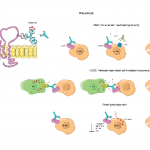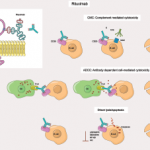NEW YORK (Reuters Health)—Compared with cyclophosphamide, rituximab treatment poses less malignancy risk in patients with antineutrophil cytoplasmic antibody (ANCA)-associated vasculitis (AAV), European researchers report.
Dr. Emma E. van Daalen of Leiden University Medical Center in the Netherlands tells Reuters Health, “Previous studies reported an increased malignancy risk in patients with AAV, which has been associated with exposure to cyclophosphamide and other immunosuppressive agents.”
“Rituximab has emerged as an alternative treatment to cyclophosphamide and is now approved for the treatment of AAV,” she says. However, whether rituximab would influence the malignancy risk was not known, given the findings of two earlier clinical trials.
“In the RAVE trial, six of 124 patients who received rituximab (5%) developed a malignancy, compared with one of 73 patients who were not exposed to rituximab (1%),” Dr. van Daalen observes. “In the RITUXVAS trial, two malignancies were observed in rituximab-treated patients.”
To investigate, Dr. van Daalen and colleagues assessed malignancy rates in AAV patients treated between 2000 and 2014, including 119 who received only cyclophosphamide, 41 who received only rituximab, 114 who received both and 48 who received neither.
As reported in Annals of the Rheumatic Diseases, online on Nov. 29, 33 patients developed a total 45 malignancies during an average followup of 5.6 years. This represented a 1.89-fold increased malignancy risk overall, for AAV patients compared to the general population.
The risk increase was not significant if non-melanoma skin cancer was excluded from the analyses (standardized incidence ratios, 1.09). The risk of non-melanoma skin cancer alone was increased 4.58-fold overall.
Further analyses showed that patients treated with cyclophosphamide had an increased malignancy risk compared with the general population (SIR, 3.10), but patients treated with rituximab did not (SIR, 0.67). The malignancy risk for patients treated with cyclophosphamide was 4.61-fold greater than for rituximab-treated patients. In addition, the malignancy risk was lower (about a three-fold increase) for patients treated with both drugs compared with those treated with cyclophosphamide alone.
Summing up, Dr. van Daalen says, “We were the first to study malignancy risk over a longer time period in a large cohort of AAV patients treated with rituximab (and) we found that (those) patients had a strikingly lower malignancy risk than those treated with cyclophosphamide” and no increased risk compared to the general population.
“Clinical trials have shown the noninferiority of rituximab compared to cyclophosphamide for induction of remission,” she continues. “However, whether rituximab should substitute for cyclophosphamide in all patients with AAV remains a topic of debate, since it has been argued that the evidence for rituximab as the preferred mode of AAV treatment requires further investigation. Our data requires confirmation in an independent cohort before it can be used to support preferential use of rituximab.”

